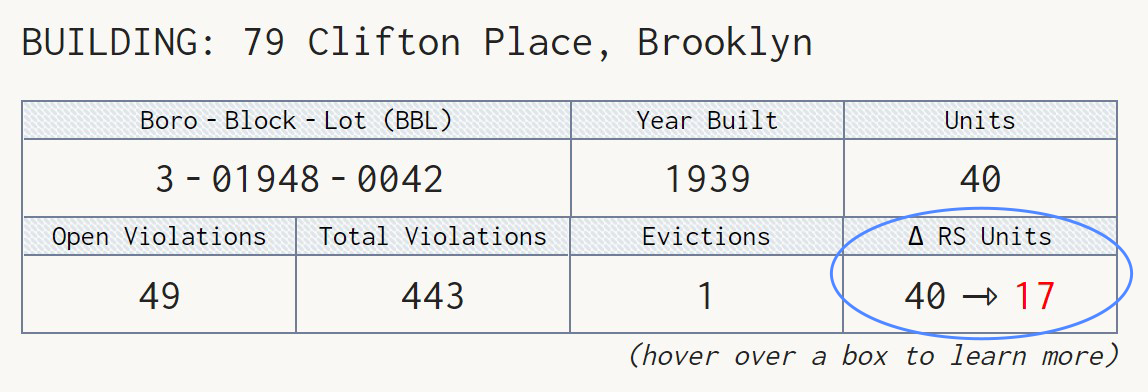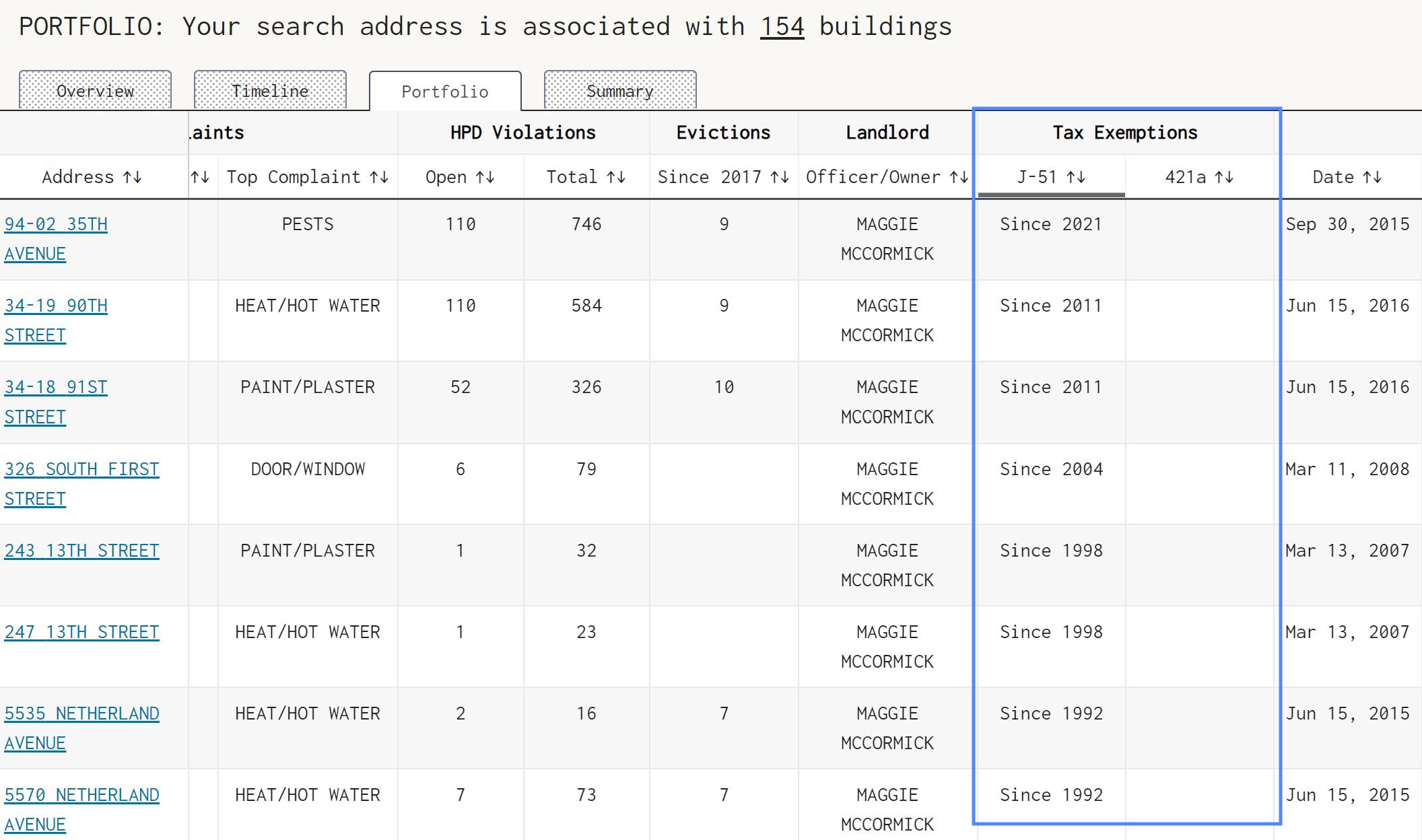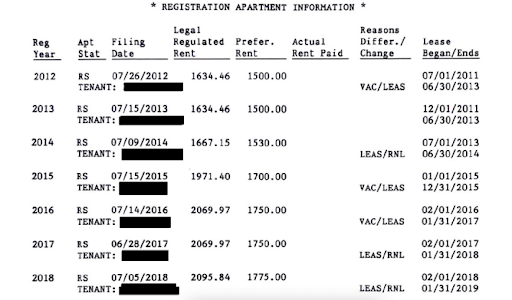Rent History 101: Is your landlord illegally overcharging you?
Rent History 101: Is your landlord illegally overcharging you?
This article was written by the team of housing experts at JustFix
Summary
Find out if your landlord illegally deregulated your apartment or illegally increased your rent. Learn how to read your rent history and identify red flags.
What can JustFix do?
Use our online tool to order your rent history
In New York City, rent stabilization safeguards more than one million apartments, protecting tenants from drastic rent hikes and evictions without good cause. This article will help you explore whether your apartment is rent stabilized and, if so, how to detect illegal rent increases.
Take the first step in your journey to understanding your apartment status and rent by ordering your rent history.
What is a rent history and how do I get mine?
New York State maintains a private database of rent stabilized apartments, listing former tenants and their “legal” rents between 1984 and today. While the general public has no right to order a copy of your apartment’s rent history, you, as the occupant of your apartment, have the right to request a copy via mail or in person. JustFix’s Rent History Tool helps you request your rent history from the New York State Division of Homes and Community Renewal ("DHCR”) via snail mail (DHCR won’t email copies). Any occupant of an apartment with access to the mailbox can make the request. Tenants can also obtain a same-day copy of their rent history by visiting a DHCR borough office. Make sure to call first to make an appointment and bring proper identification and proof of address.
What if there’s no rent history for my unit?
In order to obtain a rent history, your landlord must have reported the rent stabilized status of your apartment to the State agency, DHCR, at least once since 1984. Check out JustFix’s Who Owns What tool to explore whether your landlord has registered any apartments in your building as stabilized in the last decade or so. Who Owns What can tell you how many units your landlord registered as rent stabilized but does not release unit-by-unit data. That’s why you need to order your Rent History.


Caption: Who Owns What reports changes in rent stabilized unit registration between 2007 and present day. As you can see, the building on Sheridan Avenue has remained fully rent stabilized while the owner at 79 Clifton Place reports having deregulated more than 50% of the building’s units since 2007.
If the State cannot locate your rent history, this could mean that your apartment is either not rent stabilized or the landlord failed to properly register it as stabilized.
Here are some other reasons you might have trouble requesting a rent history:
Your building has more than one mailing address: Large buildings that span more than one mailing address or buildings that are situated on a corner may have more than one address. For example, 1510 Sheridan above is actually known as 1520 Sheridan Avenue to its tenants. Try with an alternative address before you give up!
Your individual unit once had a different number: Sometimes landlords re-number apartments, making it hard for the State to locate your real rent history. Make friends with long-term tenants in the building and ask them if the landlord ever re-labeled your unit. If so, try the old apartment number/letter.
Your landlord violated the law by failing to register your apartment: If you think your apartment should be rent stabilized but there’s no rent history, your landlord may be violating the law. Read on to learn more.
What if my landlord never registered my building or apartment as rent stabilized?
Generally, apartments become rent stabilized in two ways*:
Because of the age and size of the building: Apartments in rental properties built before 1974 with six or more units are subject to rent stabilization (or at least once were!); OR
Because of a tax abatement like J-51 or 421-a: These tax abatements encourage landlords to construct new residential housing, meaning these stabilized units often appear recently renovated. In short, all tenants in buildings receiving these tax abatements should receive rent stabilized leases. Research whether your building has a tax exemption using Who Owns What.

If you think your apartment should qualify as rent stabilized, you can file a complaint with DHCR and ask them to take two steps.
First, write a letter to DHCR asking for an “administrative determination” that your apartment is rent stabilized. Provide a copy of all your leases (first and any renewals) as well as any proof you are rent stabilized, including government websites showing that your building has (or had when you moved in) J-51 or 421-a benefits. You can mail these documents to:
Director, Multi-Service Unit
Property Management Bureau
92-31 Union Hall Street
Jamaica, NY 11433
Second, getting recognized as rent stabilized is just the first step in your journey to stable, long-term rental housing. Later on, DHCR may ask you to file a rent overcharge complaint to get your rent lowered and recoup past overpayments (plus potential damages and interest). In addition to your leases, you’ll need to provide rent bills and proof of past rent payments so save all your apartment-related paperwork.
*note: there are other ways an apartment can become rent stabilized but these are the two most common ways.
I got my rent history but I don’t understand it. Help!
You will undoubtedly find your rent history long and perplexing. This is because DHCR does not require landlords to provide explanations when they increase rents, even when registering large jumps in the rent. Generally, landlords only need to offer you and NY State an explanation of their logic when challenged in a lawsuit or complaint within a specific time frame.
Take a deep breath and let’s get started with these tips to identify red flags:
Tip 1: Work backward & look for large jumps in the rent
Yes, rent histories often go back to 1984. But if you file a complaint, DHCR will most closely consider the rent increases in the last four to six years. If there’s evidence of intentional fraud — that is, a landlord increasing the rent without a legal basis — DHCR will look back farther. Starting from the last year, scan your rent history for any huge jumps in the rent and use the resources below to see if those jumps make sense.
Because the rent laws change periodically, the amount a landlord can increase the rent changes from year to year. In 2019, the law changed to eliminate loopholes that allow for large rent increases. Because of these changes, you should note whether rent jumps occurred before or after 2019 (when the Housing Stability and Tenant Protection Act (“HSTPA”) passed). Simply put, large increases or deregulations occurring after June 2019 are usually suspicious.
Large Rent Hike Reason 1: Vacancies When a tenant moves out, this is called a “vacancy” because the apartment becomes empty at least for a short period of time. If the vacancy occurred before 2019, you may see a legal increase of around 20%. Prior to 2019, sometimes landlords created “fake” tenants in order to report a vacancy and increase the rent 20%. So, ask your long-term neighbors if they remember the tenants listed on your rent history. In addition, when you file a complaint, the landlord may need to provide past leases and other proof of that tenancy to DHCR.
Large Rent Hike Reason 2: Individual Apartment Improvements (“IAIs”) If you see an increase larger than 20% before 2019, you can assume the landlord relied on the cost of renovations (called Individual Apartment Improvements (“IAIs”)). Look around your apartment and do some math. Does your apartment look like it received renovations during the time period that the rent increased more than 20%? Do you have a new bathroom? New kitchen? Brand new appliances? Based on your building size, figure out how much the landlord would have needed to spend prior to 2019:
Buildings of 35 or fewer units: Landlords could add 1/40th of the cost of renovations into the rent permanently.
Buildings with more than 35 units: Landlords can add 1/60th the cost of renovations into the rent.
Note: IAIs should not include basic maintenance like repairing broken appliances, painting, or patching floors.

Caption: Between 2013 and 2014, the landlord increased the rent by nearly $2,000 or more than 400%. Even though this jump happened many years ago, an increase this large may indicate fraud and may allow a longer look back.
Tip 2: Watch out for preferential rents Landlords sometimes tell tenants they are getting a deal, called a “concession” or “preferential” rent. A preferential rent will often appear on the lease itself next to a larger number that represents the “legal” rent (i.e. what the landlord reports to the state as the maximum amount they could charge). Concession rents, on the other hand, often take the form of free months of rent (either upfront or during the first lease).
Tenants with these “deals” rarely complain or even order rent history, and courts have therefore found that preferential rents often serve to disguise fraud. If you have a preferential or concession rent, DHCR or a court might be willing to look back farther in your rent history for an overcharge.

Caption: Because this landlord has offered a preferential rent for many years, filing a complaint may trigger an investigation going back farther in time!
Tip 3: Watch out for huge, abrupt de-regulations! Prior to 2019, once rents hit a specific “magic number,” landlords could remove an apartment from rent stabilization forever. Once removed from rent stabilization, a unit becomes “market rate,” meaning future tenants have no protections against large rent increases or eviction without good cause.
If you see that your landlord stopped registering your apartment before 2019, it may be because the landlord increased the rent above the thresholds listed below. It may take a lawyer’s assistance to help you determine if the landlord deregulated the unit illegally. But, no matter when deregulation happened, if your landlord illegally removed a unit from rent stabilization, you can file a complaint asking for recognition of your rent stabilized status.
Rent Amount Necessary to Deregulate:
June 19, 1997 - June 23, 2011 : $2,000
June 24, 2011 - June 14, 2015 : $2,500
June 15, 2015 - June 13, 2019 : $2,700+ yearly RGB increases
June 14, 2019 : High rent decontrol repealed!

Caption: Example of a mysterious and abrupt deregulation. After 2006, the landlord claimed this apartment “exempt from registration” without explanation! Other landlords may just have stopped registering rents altogether and the rent history could say “no registration found."
Tip 4: Learn how rents legally increase Rent stabilized tenants get to choose between one- and two-year leases at every lease renewal, and, in New York City, the Rent Guidelines Board (“RGB”) determines the percentage increase. New increases take effect for all leases that start on or after October 1st. Because the RGB is politically appointed, the mayor plays a key role in how much the rent goes up (anywhere from 0-9% historically). Knowing about these increases not only helps you read your history but prepares you for rent increases going forward. Check out this chart on the RGB website to understand rent increases over time and to get information about this year’s increases.
That’s a lot of information! Is there anyone that can help?
Don’t worry! Confusion is normal because rent histories do not contain enough information for you to understand them completely or know whether the landlord’s report proves truthful. But, your rent history will provide clues to get you started.
Low-income households can call your local Legal Aid or Legal Services office to ask for a legal consultation or for information about a local legal clinic. You can also request a consultation through the New York City Bar Association. If your overcharge or illegal deregulation case appears strong, a lawyer may take it on contingency — meaning they’ll take a percentage of your winnings but won’t charge you upfront.
To challenge your landlord’s rent increase calculations, you can file a case in New York state court (for that, you’d want to retain an attorney),or you can file a complaint on your own with DHCR. Remember, landlords can report anything they want on a rent history; increases may have no basis in law or math. It’s up to you to report illegal rent hikes!
Why should I try to get my apartment declared stabilized or my rent lowered?
Other than enjoying a lower rent, helping to bring a unit back into stabilization also keeps rents affordable for future tenants. If tenants do not file complaints, landlords can register rents at whatever level they like without ever facing penalties.
It may take years, but, if you prevail, you could receive all the rent you overpaid back with interest. If you can prove the overcharge was “willful” or on purpose, you could receive “treble damages” or three times your overpaid amount back, with interest!
Encourage your neighbors to file complaints too. If your landlord is engaging in rent fraud with your apartment, chances are the landlord has done the same thing to other tenants in your building or even across their portfolio.
Want to get started on forming a tenant association? Read our Tenant Organizing Resources guide created by organizers and tenants participating in our Design Advisory Council (“DAC”).
